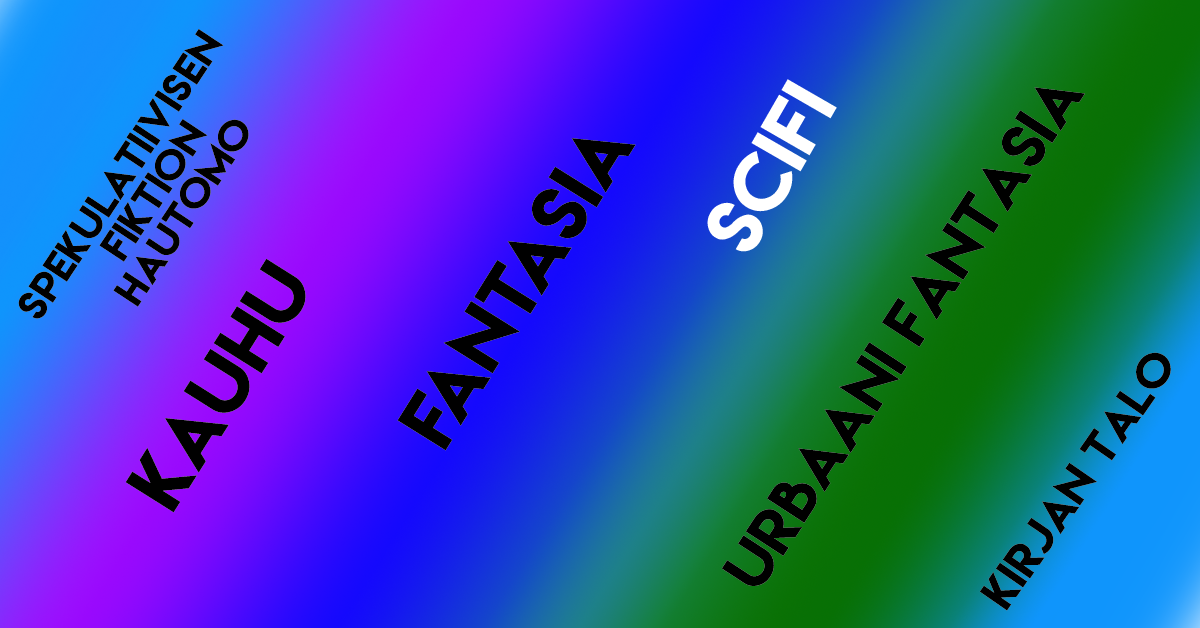In English Below
Neljäs Kirjan talon spekulatiivisen fiktion hautomo vei minut mukavuusalueelle. Tieteiskirjallisuuteen meidät perehdytti kirjailija Shimo Suntila, jonka opeista tarttui mukaan paljon pureskeltavaa.
Alusta asti oli selvää, että Suntila tiesi, mistä puhui, ja muistiinpanoja kertyi paljon. Yksinkertaisimmillaan scifin voidaan todeta perustuvan tieteeseen. Avaruuteen sijoittuvat tarinat on helppo tunnistaa scifiksi, mutta Suntila muistutti, että kyse voi olla myös muista tieteistä, kuten antropologiasta, sosiaalitieteistä, lääketieteestä tai luonnontieteistä. Scifitarinoiden tapahtumat ovat yleensä selitettävissä tieteen keinoin, eikä tiedettä vastaan varsinaisesti rikota, vaikka sen lainalaisuuksia voidaankin taivutella.
Suntila painotti kuitenkin hyvän tarinan tärkeyttä. Joskus tieteellinen periaate voidaan nakata roskakoriin, jotta tarinasta saadaan kiinnostavampi ja toimivampi. Tieteisulottuvuuden tulee kuitenkin olla tarinan ydin ja vaikuttaa henkilöhahmojen toimintaan. Juonen tulee käsitellä inhimillisiä ongelmia, mutta linkittyä elementtiin, joka tekee tarinasta tieteistarinan. Samanlaisen ohjeen saimme J.S. Meresmaalta eeppisen fantasian kurssikerralla. Siinä missä fantasia tuo tunnistettavaan maailmaan taikaa, scifi tuo siihen tiedettä.
Kovaa vai pehmeää?
Suntilan mukaan tieteiskirjallisuudessa liikutaan usein mahdottoman ja mahdollisen rajapinnoilla. Scifi voi omaksua erikoisia ideoita, mutta pysyä silti etäisesti mahdollisena. Kovaan ja pehmeään tieteiskirjallisuus voidaan jakaa sen perusteella, miten mahdollisena sen luomaa asetelmaa voidaan pitää.
Kovassa scifissä tekniikka toimii mahdollisimman realistisesti. Pehmeässä scifissä voidaan oikoa ja tehdä myös mahdottomia ratkaisuja. Esimerkiksi H.G. Wellsin tuotantoa voidaan pitää pehmeänä scifinä ja Jules Vernen kirjoja kovana scifinä.
Toinen tieteiskirjallisuudelle tyypillinen kahtiajako ovat dystopiat ja utopiat. Itse olen ehdottomasti dystopian ystävä. Ei pelkästään synkkien maailmoiden vuoksi, vaan myös siksi, että dystopioissa asuu toivo. Kun asiat ovat jo lähtökohtaisesti pielessä, pitää toivo kaiken kasassa ja vie tarinaa eteenpäin. Toivo on myös elementti, joka voi tehdä altavastaajasta sankarin.
Vaihtoehtohistorioita
Kävimme läpi myös erilaisia scifin alalajeja avaruusoopperasta aikamatkailuun. Omat suosikkini löytyvät vaihtoehtohistorioista, joista tunnetuin lienee tällä hetkellä steampunk höyrykoneineen ja ilmalaivoineen. Itseäni kiehtoo eniten cyborgien, neonvalojen ja synkkien tulevaisuusskenaarioiden cyberpunk. Suntilan mukaan seuraava merkittävä alalaji saattaa olla aurinkoenergian valjastava solarpunk, joka voi tarkastella myös ilmastonmuutokseen liittyviä uhkakuvia.
Vaihtoehtohistorioissa jokin asia maailmankirjoissa on mennyt toisin. NaNoWriMo-tekstissäni tarkastelin melko perinteistä Steampunk-maailmaa, jossa ilmalaivat täyttävät taivaan ja päähenkilö työskentelee höyrykonetehtaalla. Merenkulku on jäänyt espanjalaisille ja kreikkalaisille kauppalaivastoille sekä Pohjoismaissa eläville merenkävijöille. Olen tuonut tarinaan mukaan myös alkemisteja ja salatieteitä. Tekstissä ollaan lähellä 1900-luvun alkua ja siten myös ensimmäisen maailmansodan syntyyn vaikuttavia tekijöitä. Samaan aikaan, kun Nikola Tesla tekee kaikessa hiljaisuudessa kokeilujaan sähköllä, pelkää alkemistien salainen veljeskunta uuden energiamuodon syrjäyttävän heidän valtansa.
Vaihtoehtohistorioiden ja toisenlaisten maailmojen kehitteleminen kiehtoo minua scifissä eniten. Suntilan mukaan vieraiden asioiden kokeminen on scifissä tärkeää, ihmisten reaktiot vierasta tai uutta kohtaan tuovat inhimillisyyttä tarinaan. Siellä missä on konflikti, on myös tarina.
Lue lisää ajatuksistani spekulatiivisen fiktion hautomosta.
Lukuvinkki: Shimo Suntila: Sata kummaa kertomusta. 2013, Kuoriaiskirjat. ISBN 978-952-7021-16-3
In English
The fourth meeting of my fantasy and sci-fi writing class took me to my comfort zone. Author Shimo Suntila introduced us to the world of science fiction.
Suntila knew what he was talking about. Science fiction should always have some science in it. We easily recognize stories happening in space as sci-fi, but Suntila reminded us that besides technology there might be other sciences involved too, like social sciences, anthropology or medical science.
Suntila emphasized the importance of a good story. Sometimes the scientific principles can be tossed to trash if it makes the story more interesting and functional. The plot should deal with problems readers can recognize, but still, have the sci-fi element to affect the behavior of the characters. The idea is very similar than the one J.S. Meresmaa introduced to us when she was talking about epic fantasy.
Hard or soft, dystopias or utopias?
According to Suntila, science fiction often balances on the border of impossible and possible. Sci-fi can embrace some wild ideas but still keep its set at least a little bit plausible. Sci-fi can be divided into hard and soft according to how possible the story’s set up is.
In a hard sci-fi, the technology works as realistically as possible. The soft sci-fi can make some short cuts and use more impossible solutions. For example, H.G. Wells’ books can be seen as a soft sci-fi and Jules Verne’s books as hard sci-fi.
Dystopias and utopias are also very typical of science fiction. I am definitely a fan of dystopias. Not only because of the dark worlds, but also because of the hope that dystopia holds in. When everything goes wrong, hope makes changes possible and keeps the story breathing. Hope is also an element that can turn an underdog into a hero.
Alternative histories
We also went through a variety of science fiction subgenres from space opera to time travel. My favorite ones can be found in alternative histories. The most known one at the moment is probably steampunk with airships and clockwork machines. I, myself, am more fascinated by the cyberpunk and the cyborgs, neon lights and gloomy future scenarios. According to Suntila, the next major alternative history variation might be the solarpunk, which harnesses solar energy and can also take a view on climate change.
In alternative histories, something in the world has gone differently. In my NaNoWriMo text, I wrote about the rather traditional Steampunk world, where airships filled the skies and the protagonist worked at the steam engine factory. The seas were left to Spanish and Greek merchants and seafarers living in the Nordic countries. I have also brought alchemists and some occultism in the script. The story takes place close to the beginning of the 20th century, and First World War. At the same time as Nikola Tesla is experimenting with electricity, the secret brotherhood of the alchemists fears that the new form of energy will displace their power.
Developing alternative histories and different worlds fascinate me most in sci-fi. According to Suntila, experiencing strange things is important in science fiction. People’s reactions to strange or new things bring humanity to the plot. Where there is conflict, there is also a story.

